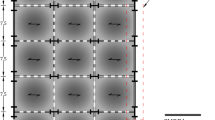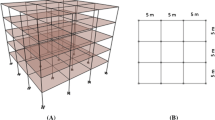Abstract
Tuned mass dampers (TMDs) can be used to absorb the input energy of the applied loads, and reduce the response of building frames. However, inherited uncertainties in structural characteristics of building frames can significantly affect their response and counteract the effectiveness of vibration absorbing devices such as TMDs. In this study, by calculating cumulative damage indices for stories of the structure, failure probability of two steel moment-resisting frames equipped with TMDs has been studied in presence of uncertainty in characteristics of the structure. Cumulative inelastic deformation of structural elements in each story has been used to calculate the damage representative of that story, based on weighted average approach. Even though the cumulative response of the deterministic model of the structures is reduced by installing TMDs, the results of the numerical simulations on the probabilistic response of the sample structures indicate that for the records that cause excessive damage in the lower stories of the structures, the effect of TMDs on failure probability of the structure can be detrimental.
Similar content being viewed by others
Refrerences
Nowak, A. S. and Collins, K. R. (2000). Reliability of structures. McGraw-Hill, New York, NY.
Baecher, G. B. and Christian, J. T. (2003). Reliability and statistics in geotechnical engineering. Wiley, Chichester, New York, NY.
Bakre, S. V. and Jangid, R. S. (2007). “Optimum parameters of tuned mass damper for damped main system.” Structural Control and Health Monitoring, 14(3), pp. 448–470.
Den Hartog, J. P. (1956). Mechanical vibrations. 4th ed., McGraw-Hill, New York, NY.
Ditlevsen, O. and Madsen, H. O. (1996). Structural reliability methods. Wiley, Chichester, New York, NY.
Gupta, A, and Krawinkler, H. (1999). Seismic demands for performance evaluation of steel moment resisting frame structures (SAC Task 5.4.3). Report No. 132, Palo Alto, John A. Blume Earthquake Engineering Center, Stanford University, CA.
FEMA 335C (2000). State of the art report on systems performance of steel moment frames subject to earthquake ground shaking, FEMA 355C, SAC Joint Venture, Sacramento, CA.
Hadi, N. S. and Arfiadi, Y. (1998). “Optimum design of absorber for MDOF structures.” ASCE Journal of Structural Engineering, 124(11), pp. 1272–1280.
Kappos, A. J. (1997). “Seismic Damage Indices for RC Building: Evaluation of Concepts and Procedres.” Progress in Structural Engineering and Materials, 1(1), pp. 78–87.
Kratzig, W. B., Meyer, I. F., and Meskouris, K. (1989). “Damage evolution in reinforced concrete members under cyclic loading.” Proc. 5th Int. Conf. on Struct. Safety and Reliability, ASCE, New York, Vol. II, pp. 795–802.
Kaynia, N. M., Veneziano, D., and Biggs, J. M. (1981). “Seismic Effectiveness of Tuned Mass Dampers.” Journal of Structural Division, 107(8), pp. 1465–1484.
Lukkunaprasit, P. and Wanitkorkul, A. (2001). “Inelastic buildings with tuned mass dampers under moderate ground motions from distant earthquakes.” Earthquake Engineering and Structural Dynamics, 30, pp. 537–551.
McKenna, F., Fenves, G. L., and Scott, M. H. (2003). Open system for earthquake engineering simulation. Pacific Earthquake Engineering Research Center, Univ. of California, Berkeley, Calif., available in http://opensees. berkeley.edu/, retrieved January 3, 2012.
McNamara, R. J. (1977). “Tuned mass dampers for buildings.” ASCE Journal of Structural Division, 103, 1985–1998.
Mehanny, S. S. F. and Deierlein, G. G. (2001). “Seismic Damage and Collapse Assessment of Composite Moment Frames.” Journal of Structural Engineering, 127(9), pp. 1045–1053.
Mehanny, S. S. F. and Deierlein, G. G. (2000). Modeling and Assessment of Seismic Performance of Composite Moment Frames with Reinforced Concrete Columns and Steel Beams. Technical Reposrt. 135, John A. Blume Earthquake Engineering Center, Stanford University, Stanford, CA.
Mohebbi, M. and Joghataie, A. (2011). “Designing optimal tuned mass dampers for nonlinear frames by distributed genetic algorithms.” The Structural Design of Tall and Special Building, 21(1), pp. 57–76.
Nateghi-Alahi, F. and Tarbali, K. (2012). “Reliability analysis of a steel moment-resisting frame equipped with tuned mass damper under earthquake excitation.” Proc. Fifteenth world Conference on Earthquake Engineering, Lisbon, Portugal.
Park, Y. J., Ang, A. H-S., and Wen, Y. K. (1985). “Seismic Damage Analysis of Reinforced Concrete building.” Journal of Structural Engineering, ASCE, 111(4), pp. 740–757.
Pinkaew, T., Lukkunaprasit, P., and Chatupote, P. (2003). “Seismic effectiveness of tuned mass dampers for damage reduction of structures.” Engineering Structures, 25, pp. 39–46.
Rana, R. and Soong, T. T. (1998). “Parametric study and simplified design of tuned mass dampers.” Engineering Structures, 20(3), pp. 193–204.
Sadek, F., Mohraz, B., Taylor, A. W., and Chung, R. M. (1997). “A method of estimating the parameters of tuned mass dampers for seismic application.” Earthquake Engineering and Structural Dynamics, 26(6), pp. 617–635.
Soong, T. T. and Dargush, G. F. (1997). Passive energy dissipation systems in structural engineering. John Wiley & Sons, Chichester.
Soong, T. T. and Grigoriu, T. (1993). Random Vibration of Mechanical and Structural System. Englewood Cliffs, Prentice Hall, NJ.
Soto-Brito, R. and Ruiz, S. E. (1999). “Influence of ground motion intensity on the effectiveness of tuned mass dampers.” Earthquake Engineering and Structural Dynamics, 28(11), pp. 1255–1271.
Tarbali, K. (2012). A study on seismic behavior of the structures equipped with tuned mass dampers through probabilistic evaluation and reliability analysis. MSCE thesis, International Institute of Earthquake Engineering and Seismology (IIEES), Tehran, Iran
Warburton, G. B. (1982). “Optimum absorber parameters for various combinations of response and excitation parameters.” Earthquake Engineering and Structural Dynamics, 10(3), pp. 381–401.
Wen, Y. K., Ellingwood, B. R., Veneziano, D., and Bracci, J. (2003). Uncertainty Modeling in Earthquake Engineering, MAE Center Project FD-2 Report, Mid-America Earthquake Center (MAE), University of Illinois at Urbana-Champaign, Urbana, IL.
Wong, K. K. F. (2008). “Seismic energy dissipation of inelastic strucutres with tuned mass dampers.” Journal of Engineeing Mechanics, 134(2), pp. 163–172.
Wong, K. K. F. and Chee, Y. L. (2004). “Energy dissipation of tuned mass dampers during earthquake excitations.” Structural Design of Tall and Special Buildings, 13, pp. 105–121.
Author information
Authors and Affiliations
Corresponding author
Additional information
Discussion open until November 1, 2014. This manuscript for this paper was submitted for review and possible publication on September 10, 2012; approved on January 13, 2014.
Rights and permissions
About this article
Cite this article
Tarbali, K., Nateghi-A, F. Effect of structural uncertainty on seismic response of steel moment-resisting frames equipped with tuned mass dampers. Int J Steel Struct 14, 231–241 (2014). https://doi.org/10.1007/s13296-014-2004-2
Published:
Issue Date:
DOI: https://doi.org/10.1007/s13296-014-2004-2




